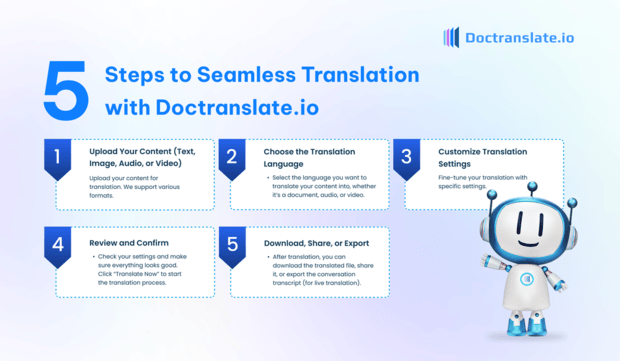Introduction
Translating academic papers is crucial for sharing research globally. It helps scholars connect across borders and expand their reach. Language barriers can significantly hinder the dissemination of important studies and findings in the academic world.
Accurate translation ensures that the nuance and precision of your original work are preserved. This is especially vital for complex subjects found in academic documents. Maintaining technical terms correctly is key.
DocTranslate.io offers a powerful solution tailored for such needs. Its AI-driven approach ensures both speed and fidelity in translation. You can trust it with your valuable research documents.
This guide will walk you through translating your academic paper seamlessly. We will focus on the steps required to translate from Traditional Chinese to English. Follow along for a smooth translation process.
Step-by-Step Guide: Translating Academic Papers from Traditional Chinese to English with DocTranslate.io
Step 1: Upload Your Content
Begin by visiting the DocTranslate.io platform. Navigate to the translation section designed for documents. This is where your translation journey starts.
Locate the upload area on the page. You can easily drag and drop your academic paper file directly into this zone. Alternatively, browse your computer to select the file.
DocTranslate.io supports various document formats commonly used for academic papers. Upload formats like PDF, Word (.docx), Excel (.xlsx), and PowerPoint (.pptx). This flexibility covers most document types.
Even scanned documents are supported, including scanned images. This means you can translate papers saved as images or non-editable PDFs. Use the Translate Document feature for these files.
Step 2: Choose the Translation Language
Once your document is uploaded, you need to specify the languages. Find the language selection options on the page. Accuracy here ensures you get the correct translation.
For the source language, select Traditional Chinese. This tells the system the original language of your academic paper. Make sure you pick the correct variant.
Next, choose English as your target language. This is the language you want your paper translated into. Selecting the right target language is straightforward.
DocTranslate.io supports a vast array of languages. While focusing on Traditional Chinese to English now, remember it can handle many other language pairs for future projects.
Step 3: Customize Your Translation Settings
After selecting languages, refine your translation using available settings. These options help tailor the output to your specific needs. Customization is key for academic precision.
Select a formal tone for your translation. Academic papers require a professional and objective writing style. Setting the tone appropriately is crucial for credibility.
If available, choose a relevant domain specialization. This helps the AI use terminology specific to your academic field. Domain settings improve technical accuracy.
Utilize features like My Dictionary or custom prompts. This allows you to input specific terms or phrases that should be translated in a particular way. Fine-tune the translation Customize Document Translation for specialized vocabulary.
Step 4: Review and Confirm
Before starting the translation, take a moment to review all your settings. Double-check the uploaded document file. Ensure it is the correct version of your academic paper.
Verify that you have correctly selected Traditional Chinese as the source language. Confirming this step prevents potential errors in the input. A quick check is always wise.
Also, make sure English is correctly chosen as the target language. This ensures the final output is in the language you need. Confirming the target language is essential.
Once you are confident with all the settings, click the ‘Translate Now’ button. The AI-driven translation process will then begin promptly. The system works efficiently to process your document.
Step 5: Download, Share, or Export
After the AI completes the translation of your academic paper, the translated file becomes available. The process is typically fast and efficient. You won’t have a long wait.
You will be able to download the translated document directly from the platform. The file will be ready in a format that preserves the original structure. Download Translated Document easily once complete.
A key feature of DocTranslate.io is maintaining the original document layout. This saves you time and effort in reformatting the translated paper. The structure stays intact.
Furthermore, the translated document is typically sent to your registered email address. It is also saved in your ‘Translation History’ on the platform. Access your translations conveniently anytime.

Conclusion
Translating Academic Paper from Traditional Chinese to English has never been easier. Thanks to DocTranslate.io, this complex task becomes simple and efficient. Break down language barriers effortlessly.
By following these straightforward steps, you ensure your research is translated accurately. The platform handles formatting and technical terms, maintaining the integrity of your work. Accuracy and layout preservation are key benefits.
Explore other capabilities of DocTranslate.io for various needs. Translate text with Translate Text, understand images using Translate Image, convert audio with Translate Audio, or subtitle videos via Translate Video.
Start translating your academic papers and other content today. Experience the benefits of reaching a wider, global audience. New users even receive 5 free credits to begin! Visit DocTranslate.io to get started!


Leave a Reply